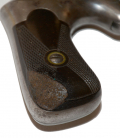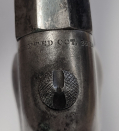site search
online catalog
CONNECTICUT ARMS AND MANUFACTURING CO. HAMMOND .44 RIMFIRE “BULLDOG” DERINGER, CA. 1865-1868

$750.00 SOLD
Quantity Available: None
Item Code: 490-6878
This single-shot Deringer would go well in a display of vest and coat-pocket pistols carried for personal defense in the early west. It rates about very good for condition, with smooth metal, and clear markings, and about 15% finish- no appreciable signs of casehardening on the frame, which shows a silver gray with darker gray and thin brown stains, but with significant thin blue left on the barrel. The button/rear sight shows some deep blue and the spur trigger shows some blue on the underside as well. The thermoplastic (or “Mud”) grips fit well and have good detail and color, but hold it back by a large surface chip at the lower right rear. The mechanics are good. The bore is clean, with visible rifling.
Brothers Henry and Lewis Hammond tried to enter the Civil War military arms business by incorporating in mid-1863 and developing a breech-loading single-shot cartridge system. A patent, however, was only granted in late October 1864 and attempts at a military contract for longarms were unsuccessful. They had a little more luck with their Deringer pistol, which used the same sort of swivel breach block that pivots to the left for inserting a cartridge after placing the hammer at half-cock and depressing a button on top of the block. The button is cross-hatched, but also slotted to function as a rear sight, and the block is fitted with an automatic ejector that will partially lift out the cartridge case for removal.
The pistol had some variations in barrel length and caliber. This is their standard production with 4-inch barrel, “gutta-percha” (thermoplastic) checkered grips, chambered for the .44 rimfire cartridge. The pistol is elegantly styled, at least by the taste of the day: the rear of the pistol features very round contours with flat-sided but bag-style grips (of then modern thermoplastic) with rounded butt, and rounded sides to the receiver. The barrel, however, is octagon, with the bottom flats having rounded ends giving the impression of flutes in the frame and the barrel giving the appearance of narrowing by a tapering top barrel flat that comes to a point beyond the front sight, effectively making it seven-sided at the muzzle. Along with the use of a spur trigger, those smooth lines may also have given it some appeal to the practical-minded looking for pistol that could be smoothly drawn from a pocket, but the pistol was also robustly constructed to handle the .44 caliber round.
The barrel address is good and reads, “CONNECTICUT ARMS & MANF’G CO NAUBUC CONN.” The breechblock is marked over the forward top edge, “PATENTED OCT 25. 1864.” The marking is good and clear, though we note a “T” intruding on the “1” of the date and another letter faintly showing under the “4,” indicating the “patented” part of the stamp may have slipped to the side in the first application.
We have not removed the grips to check the serial number on the frame, but production data is not available. Flayderman estimates a total quantity of 8,000, but also thinks production lasted from 1866 to the late 1880s. They actually had a much shorter run, however, so production may be significantly under that. They are generally assumed to have been introduced in 1865, though the ejector and rear sight did not receive patents until mid-1866 and very early 1867 according to Tim Prince, though they may have pushed forward anyway, with the obvious October 1864 patent date deemed a sufficient warning. In any case, production was very limited and in number and time. Henry Hammond reportedly filed some later firearms related patents, but the NRA museum notes that production ceased in 1868 and Mike Helms notes the company assets were sold off in 1872. Many of the pistols, however, remained in dealer inventories and were advertised for sale into the 1880s, perhaps the origin of Flayderman’s estimate of the production period.
For details on the use of thermoplastic and other materials for grips during the period see Hardman’s article, “Gutta-Percha, Hard-Rubber and Synthetics in Firearms” in the bulletin of the American Society of Arms Collectors, No. 96, pp. 15-38. We know some collectors of period thermoplastic photographic cases have attempted repairs, and some may have done it on pistol grips. We are unfamiliar with the techniques, but there is likely information out there and it could be worth it on this pistol.
The pistol has acquired the nickname “bulldog” among collectors. This may be a faulty recollection of the barrel inscription “BULL DOZER” found on some of these with a nickel finish, but either nickname is a reminder of its persuasive abilities at close range. [sr] [ph:L]
DISCLAIMER: All firearms are sold as collector's items only - we do not accept responsibility as to the shooting safety or reliability of any antique firearm. All firearms are described as accurately as possible, given the restraints of a catalog listing length. We want satisfied customers & often "under" describe the weapons. Any city or state regulations regarding owning antique firearms are the responsibility of the purchaser. All firearms are "mechanically perfect" unless noted, but again, are NOT warranted as safe to fire.
~~~~~~~~~~~~~~~~~~~~~~~~~~~~~~~~~~~
THIS ITEM, AS WITH ALL OTHER ITEMS AVAILABLE ON OUR WEB SITE,
MAY BE PURCHASED THROUGH OUR LAYAWAY PROGRAM.
CLICK HERE FOR OUR POLICIES AND TERMS.
THANK YOU!
Inquire About CONNECTICUT ARMS AND MANUFACTURING CO. HAMMOND .44 RIMFIRE “BULLDOG” DERINGER, CA. 1865-1868
For inquiries, please email us at [email protected]
Most Popular
Historical Firearms Stolen From The National Civil War Museum In Harrisburg, Pa »
Theft From Gravesite Of Gen. John Reynolds »
Selection Of Unframed Prints By Don Troiani »
Fine Condition Brass Infantry Bugle Insignia »
Wonderful Condition Original Confederate-Manufactured Kepi For A Drummer Boy Or Child »
featured item
SCARCE PALMETTO MUSKET SOCKET BAYONET
Very fine condition socket bayonet for the Palmetto musket. It has been cleaned, and exhibits light pitting throughout, with slightly heavier pitting on the socket. “SC” marking clearly visible on the blade. William Glaze and Thomas W.… (490-7077). Learn More »













